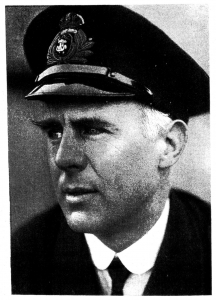Our Portrait Study: Lieutenant Norman Wilkinson, RNVR
The Yachting Monthly, June, 1917
During its early years, The Yachting Monthly presented a portrait study of some person best representing those qualities the magazine held in highest regard: a strong, upright character, leadership, seamanship, a love of sport, etc. The first portrait study was of HM King Edward, VII. During the war, when the magazine acted as the official publication for the RNVR, a number of volunteer officers were presented.
The June, 1917 issue included this study:
The Yachting Monthly, June, 1917
During its early years, The Yachting Monthly presented a portrait study of some person best representing those qualities the magazine held in highest regard: a strong, upright character, leadership, seamanship, a love of sport, etc. The first portrait study was of HM King Edward, VII. During the war, when the magazine acted as the official publication for the RNVR, a number of volunteer officers were presented.
The June, 1917 issue included this study:
As our art critic remarks this month, several familiar names are missing from this year.s Royal Academy. The reason is the now familiar one, that they are otherwise engaged. Many of our marine artists are rendering war service, and naturally they are doing so in the element they love, and which they have so often portrayed for our gratification. The work of Lieut. Norman Wilkinson is familiar to most of us. The sea and all it carries he has made his own. For many years he has knocked about on it in all parts of the world on tramps, trawlers and liners, on battleships, destroyers and transports. Records of his voyagings are memorized or put upon canvas, and from time to time we see the results on the walls of Burlington House and other exhibitions of art. He owns the 11-ton Falmouth Quay Punt Wild Rose, and for some years he has boxed about in her in search of sport and material for his sketch book. He has made some fine racing pictures, and on two occasions he painted the races for the America.s Cup at New York.
In the present war Lieut. Wilkinson first saw service in the Dardanelles, landing at Suvla with a water-colour paint box and some paper. The results were exhibited recently in London, having first been examined and admired by His Majesty and the Lords of the Admiralty. These were the first pictorial records of the great undertaking, which, although ranked as a failure at the time, had a considerable influence on the war in other spheres, and may yet be counted an influential factor towards the main objective. The drawings, although slight, were faithful representations of the scene as viewed from seaward, and we found in them the colour and atmosphere of that corner of the Eastern Mediterranean whither the eyes of the world have so long been turned. Thereafter he put in eight months on an armed yacht in the Mediterranean, and he now serves on one of the familiar aquatic Fords of the Patrol. Presently we may have the good fortune to see some pictorial results, for, keen sailor as he is, he is beyond all else an artist of retentive memory, and as he tells a good story as well as paints a fine picture, we may get both in that elusive season.after the war.
In the present war Lieut. Wilkinson first saw service in the Dardanelles, landing at Suvla with a water-colour paint box and some paper. The results were exhibited recently in London, having first been examined and admired by His Majesty and the Lords of the Admiralty. These were the first pictorial records of the great undertaking, which, although ranked as a failure at the time, had a considerable influence on the war in other spheres, and may yet be counted an influential factor towards the main objective. The drawings, although slight, were faithful representations of the scene as viewed from seaward, and we found in them the colour and atmosphere of that corner of the Eastern Mediterranean whither the eyes of the world have so long been turned. Thereafter he put in eight months on an armed yacht in the Mediterranean, and he now serves on one of the familiar aquatic Fords of the Patrol. Presently we may have the good fortune to see some pictorial results, for, keen sailor as he is, he is beyond all else an artist of retentive memory, and as he tells a good story as well as paints a fine picture, we may get both in that elusive season.after the war.
